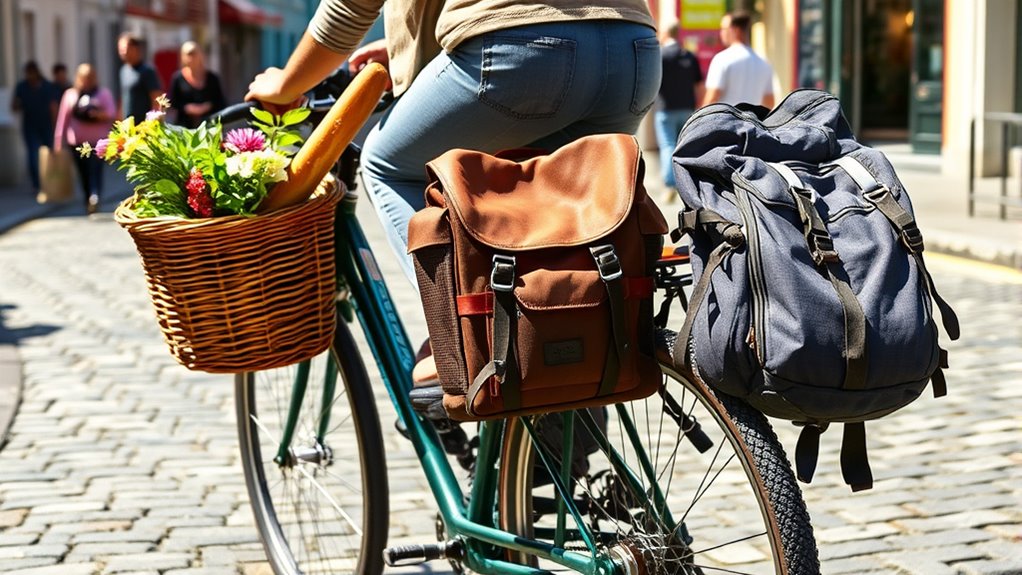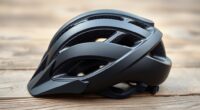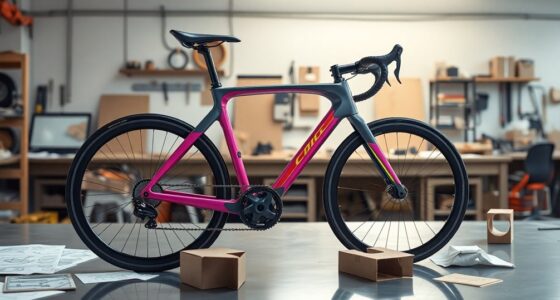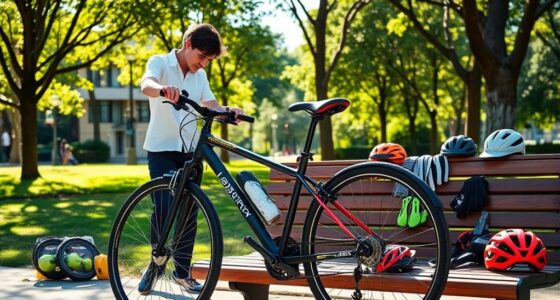When choosing between baskets, panniers, and backpacks, consider how much you need to carry and your trip length. Baskets are great for quick access to light, small items but limit capacity. Panniers provide ample, stable storage for longer trips and heavier loads, mounted on the bike’s rack. Backpacks offer flexibility and mobility but can cause discomfort if overloaded. If you want to find the best option for your rides, uncover more details below.
Key Takeaways
- Baskets are quick and easy for small, light items but limited in capacity and can affect handling if overloaded.
- Panniers offer larger, balanced cargo capacity suitable for long trips but require installation and add weight.
- Backpacks provide versatility and mobility, ideal for multi-modal travel but may cause fatigue if overloaded.
- Choice depends on load size, trip length, convenience, and whether quick access or capacity is prioritized.
- Overloading any option can impair bike handling; selecting suitable gear enhances safety and riding comfort.

Cycling is an eco-friendly and efficient way to get around, but carrying your belongings can sometimes be a challenge. Whether you’re commuting, running errands, or heading out on a weekend ride, knowing how to transport your stuff safely and comfortably makes a big difference. There are a few popular options: baskets, panniers, and backpacks. Each has its advantages and disadvantages, so understanding which suits your needs best helps you make the most of your ride.
Cycling offers eco-friendly transport, but choosing the right gear-carrying option enhances your ride.
Baskets are a classic choice and offer quick access to your gear. They’re usually mounted on the front handlebars or the rear rack, making it easy to toss in groceries, a small bag, or a jacket. Baskets are simple, lightweight, and don’t require much setup, but they do have limitations. They typically hold less weight, so if you’re carrying heavy or bulky items, they might not be the best option. Also, because they sit on the front or rear, they can affect your bike’s balance, especially if overloaded, making steering less precise. Additionally, baskets can sometimes interfere with handling if overloaded or improperly mounted.
Panniers are a popular choice for serious cyclists and commuters who need to carry larger loads. These are bags that attach to racks on either side of your rear wheel, providing ample space and stability. Panniers distribute weight evenly, which helps maintain your bike’s balance and handling. They’re great for carrying groceries, work supplies, or clothing for longer rides. Plus, they keep your belongings protected from the elements if you choose waterproof models. The downside is that panniers take some time to install and remove, and they can add weight to your bike, potentially impacting maneuverability if you’re not accustomed to it. Additionally, panniers can enhance your bike’s cargo capacity, making your trips more versatile.
Backpacks are perhaps the most versatile option, especially if you’re a commuter or someone who often needs to switch between cycling and walking. They’re easy to carry on and off the bike, offering mobility and convenience. Modern backpacks designed for cycling come with padded straps, chest or waist belts, and reflective features, making them comfortable and safe. However, they can become uncomfortable if overloaded or if you’re riding over rough terrain. Carrying a heavy bag on your back can also cause fatigue, and it might shift during your ride, affecting your balance. Furthermore, choosing a backpack with ergonomic design can help reduce strain during long rides.
Ultimately, your choice depends on what you’re carrying, how far you’re riding, and your comfort preferences. If you mostly need to carry light items and want quick access, a basket might be perfect. For heavier loads and longer trips, panniers provide stability and capacity. If you prefer flexibility and easy on-and-off convenience, a backpack works well. Additionally, bike accessories such as racks and special bags can enhance your carrying options, making your ride more efficient and enjoyable. By considering these factors, you can select the best way to carry your stuff on your bike, making every ride smoother and more enjoyable.
Frequently Asked Questions
Which Option Is Best for Long-Distance Touring?
When choosing how to carry your gear for long-distance touring, consider comfort and capacity. Panniers are ideal because they attach securely to your bike, distribute weight evenly, and keep your load stable on rough roads. Backpacks can get uncomfortable over long distances, and baskets might not hold enough gear securely. For extended trips, panniers are your best option, offering balance, convenience, and better weight management.
How Do Weather Conditions Affect Carrying Gear?
Weather can turn your ride into a rollercoaster, drastically impacting how you carry gear. Rain can soak your supplies if you don’t waterproof them, while strong winds might make panniers sway dangerously. Hot sun can overheat backpacks, and cold can freeze your gear. Always check weather forecasts and prepare accordingly—use waterproof bags, windproof covers, or thermal insulation—to keep your gear safe and your ride smooth.
Are There Weight Limits for Baskets, Panniers, and Backpacks?
You wonder if there are weight limits for your gear carriers. Yes, each has recommended weight capacities. Baskets typically hold up to 10-15 pounds, but check your model. Panniers can carry more, around 20-40 pounds, depending on their quality. Backpacks are limited by your strength and comfort, generally 10-25 pounds. Overloading can cause instability or damage, so always stay within the manufacturer’s guidelines for safe, comfortable riding.
How Do I Prevent Gear From Shifting During Rides?
Imagine your gear as a flock of birds, each needing a sturdy branch to stay put. To prevent shifting, secure items tightly with bungee cords or straps, like anchoring each bird to its branch. Distribute weight evenly across your rack or bag, avoiding lopsided loads. Tighten straps regularly during your ride, and pack heavier items low and centered for stability—keeping everything balanced and your ride smooth.
Can I Combine Different Carrying Options?
You can absolutely combine different carrying options on your bike. For example, you might use a backpack for daily essentials and add panniers or a basket for larger or bulkier items. Just make sure everything is balanced and securely fastened to avoid shifting or affecting your ride. Mixing options gives you flexibility, so you can tailor your setup to your specific needs and make your cycling experience more comfortable and efficient.
Conclusion
Ultimately, choosing between baskets, panniers, or backpacks is like picking the perfect partner for your ride—each has its own charm and purpose. Imagine your gear as a loyal companion, seamlessly riding alongside you, whether nestled in a basket, secured in panniers, or carried on your back. Whichever you choose, make sure it fits your journey’s story, turning every trip into a vivid adventure where your belongings ride smoothly, just like you do—confident and free.









